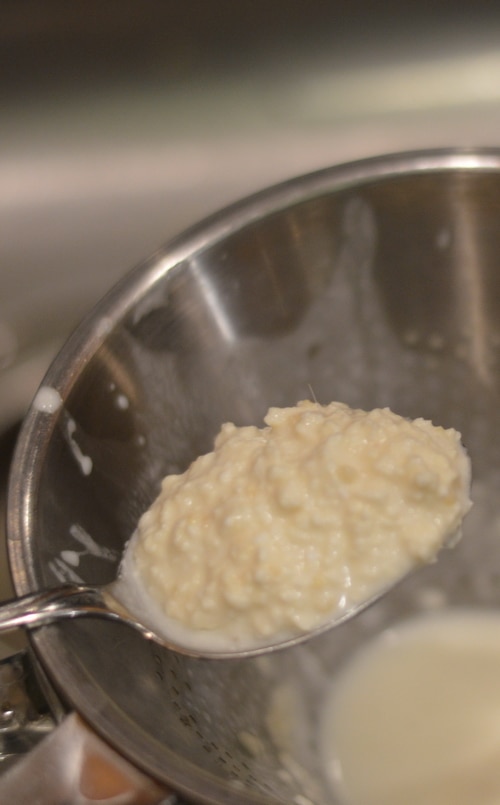Kefir (pronounced Kaw-feer) is the easiest probiotic to make at home. You don’t need special equipment, like you do with fermented vegetables. You don’t need special temperature controlled environments and packaged cultures like you do with yoghurt. You don’t even need a real sterilized environment for kefir to grow. Clean is good enough when making kefir.
Kefir is rich in more beneficial cultures than yoghurt or fermented veggies. While yoghurt contains Streptococcus thermophiles, Lactobacillus acidophilus,and sometimes Lactobacillus bulgaricus, Kefir has a broader range of beneficial bacteria, including these 3. Kefir culture is more diverse and therefore more beneficial.
Kefir is more versatile than yoghurt and fermented veggies, too. You can use it to make a probiotic rich, thicken milk, that has effervescence, and a slight sourness. According to David Asher, author of The Art of Natural Cheesemaking and founder of the Black Sheep School of Cheesemaking, you can also use it as the bacteria for making all sorts of awesome cheese, as well as yoghurt. Kefir contains both thermophilic and mesophilic bacteria. And unlike the powdered bacterial cultures you can buy specifically for cheese making, Kefir actually adapts to the milk and changes according to the conditions that you grow it in.
How can you make kefir at home?
Kefir needs just two ingredients: milk and kefir grains. Kefir grains are a kind of SCOBY, a symbiotic community of bacteria and yeast. They look like grains of cottage cheese. Their texture is rubbery and firm, like a kombucha scoby, but milkier rather than translucent.
Kefir is made with fresh milk at room temperature.
You can use raw milk or pasteurized, but avoid ultra-pasteurized milk if you can. Kefir has also been made with milk alternatives like coconut milk, soy milk, and almond milk.
Kefir making is a simple 3 step process:
- Place kefir grains in a clean jar.
- Pour fresh milk over the kefir grains.
- Wait 24 to 48 hours. Strain out the kefir grains by pouring the fermented milk through a sieve.
- Repeat.
If you put your strained kefir milk into the fridge it will get thicker, about the thickness of a thin yoghurt.
8 ways to use Kefir
- Use your kefir as a probiotic supplement by drinking ¼ to ½ a cup a couple times a day.
- Make cream cheese. Pour your kefir milk through thick cheese cloth (This is what I use instead of cheese cloth). Separate the whey from the solids to make kefir cheese, a Turkish cheese like Lebna made from yoghurt. It’s a tasty, spreadable cream cheese that’s amazing on toasted bagels, sourdough rye, or Lamb Donairs. A similar commercial product, called “Victoria style cream cheese” here in BC, has as its ingredients: Cream, milk, skim milk powder, propylene glycol, alginate, carrageenan, locust bean gum, potassium sorbate, bacterial culture. The flavour and texture is similar. Even the keeping qualities are about the same, due to the richness of the symbiotic bacterial cultures in kefir. I’d rather have the two ingredient product, wouldn’t you? And the cost of 1 quart of milk is much less than the $13 to $15 price on the industrial product.
- Dollop it on baked potatoes, rice, or spoon it into borscht, as you would sour cream.
- Use it in place of sourdough in bread baking. It will acidify the dough and lend a sour taste without damaging the yeast.
- Use the kefir milk as the starter culture for yoghurt. Follow your recipe for making yoghurt, but instead of adding powdered yoghurt culture add ¼ cup of kefir milk to 1 quart of warmed milk (110°F), incubate overnight.
- Use kefir milk in cheese making instead of adding commercial cheesemaking cultures, which contain a limited number of beneficial bacteria. Use ¼ cup of kefir per 1 gallon of milk. (for more instructions on this fascinating use of Kefir see The Art of Natural Cheese Making by David Asher.)
- Use the whey from kefir in your fermented vegetables to add the probiotic culture.
- Bake a coffee cake with kefir.
- Add kefir to your morning granola.
How to keep your kefir happy
Consider Kefir a member of your family, like your family dog or cat. You need to feed it regularly for it to thrive. If you take care of it, it will take care of you.
Kefir thrives by being fed every 24 to 48 hours, at room temperature. If left too long the kefir will separate into milk solids and whey. It will become more acidic. This is all right if you are making kefir cream cheese. It’s not harmful. But it will be sour tasting. However, it’s possible to leave kefir grains too long without feeding them.
If you leave them on the counter for a week or more without feeding them, they can weaken and die.
If you are feeding them often enough, kefir grains will make more kefir grains. A healthy colony of kefir grains will double in size in a week or two if fed daily. You’ll want to keep between 1 tsp and 2 tbsp. of kefir grains. This amount will culture 1 to 8 cups of milk in 24 hours. When you have more than 2 tbsp. of kefir grains, you’ll have enough to split off your culture and give to a friend.

What can you do if your milk source dries up?
Kefir can thrive in a variety of different milk sources. You can feed it raw, pasteurized, homogenized, unhomogenized, skimmed, or full fat milk. You can give it cow’s milk, goat’s milk, sheep’s milk, mare’s milk, or even camel’s milk. I’ve even heard of people feeding kefir with coconut milk and almond milk. Each kind of milk will yield a different result.
You can also slow down your kefir by putting grains in fresh milk and refrigerating. It will grow more slowly in the fridge and you’ll be able to feed it less frequently.
Can you freeze kefir grains?
Last winter I put my kefir grains in the freezer. I separated them from the cultured milk, rinsed them well so that there was no residual milk clinging to them. I put them in a ziploc bag, and put them in the freezer, while I waited for our dairy goats to kid. The kefir grains survived this drastic measure from January to May. It took a few weeks of feeding them every day with warm, raw goat’s milk before they started growing again, though. While it worked, I think this winter I’ll buy commercial organic milk and feed them daily. I’ll benefit from continuing to eat Kefir during the winter, and they will thrive with daily feeding.
Where can you get kefir grains?
You can’t grow kefir grains from store bought kefir milk. You need kefir grains to beget kefir grains.
Ideally you’ll be able to get kefir grains from a friend who keeps kefir. Ask around within your community and you may find people willing to share.
If you can’t find anyone local to you that has kefir grains to share, you can buy them online. Cultures for Health have them and you can get them from Amazon. While they may seem expensive, compared to buying single use yoghurt starter, they will more than pay you back in value. If well taken care of they will outlive you.
Store bought Kefir grains come dehydrated. They look like pieces of dried up kombucha scoby, brown and hard. You reconstitute them by putting them into milk. Change the milk every 24 to 48 hours and within a week you should have vibrant alive kefir grains. (Follow the directions that come with your kefir grains.)
Still on the fence about milk kefir?
Kefir is a health ally. Many of our modern problems come from the modern, sterile, factory food diet. Kefir is a way of bringing the symbiotic microbes back into balance so our bodies can heal themselves.
Kefir might help in weightloss. See this research about the role of beneficial microbes in weight loss.
Kefir may help with depression and anxiety. See this research on the role of beneficial microbes in anxiety and depression.
Eating Kefir may help with diabetes control. See this research on the role of beneficial microbes on diabetes control.
Eating Kefir may have a protective effect in osteoporosis. See this research on the protective role of kefir against bone loss.
Your Turn:
Give kefir a try. It’s the easiest of the fermented foods to add to your lifestyle. It’s more versatile than yoghurt and not as finicky as fermented vegetables. It smells better than sauerkraut. It’s not as much work as sour dough bread. And the health benefits of adding more probiotics to your food makes it worth acquiring a taste for kefir.






I live on my own and make kefir every day with just enough milk for my granola. I wash it each morning in milk then drink the milk before adding a drop more to sit for tomorrows breakfast. I take it with me when travelling. It works best if washed and can sit in a drop of water. If you take it in milk it will curdle and taste much sourer.
You can freeze grains in fresh milk. I use a little clean jam jar, put my grains in, add milk to cover well and store in the freezer up to 6 months. When I defrost the grains they look fresh and alive and start making kefir in two days, not weeks. Freezeng grains dry will kill them. Happened to me, lol. You can use kefir anywhere you use buttermilk. My kids adore my pancakes. When I get tired of drinking kefir every day, I collect some in a big jar for baking ( I got a 2 month old jar in the fridge right now and it’s still good and not spoiled, it tastes sharper, pancakes are very tasty) and freeze the grains , until I miss kefir again. The grain l have has been my pet for 5 years now. It came from Russia where kefir is mass produced and sold in every store alongside milk and butter, and loved by everyone. For kids they put couple of teaspoons of sugar to a cup,since kids don’t really like sour stuff , but need good bacteria, especially after taking antibiotics. Also, day old kefir will relieve constipation and make things regular, two day old has no effect on BM, three days old kefir might constipate you, but still good for baking with no ill effect. In Russia kefir packaging always had a date of making stamped on it, so you knew how old it was and planed accordingly. Because it is a big industry over there, I never seen 4 day old kefir. Fresh kefir comes in daily, along with fresh bread. Sorry for the long comment. Good luck with your kefir making.
P.S. Drinking kefir next morning after a party is a hangover cure in Russia.
Thank you for the advice. I haven’t tried that yet, but I will for sure.
I would add that if your not going to be drinking this as much at ant given time but still consuming – you can barely cover the grains with milk in the fridge or counter depending on the amount of grains, and even bring them in and out of the fridge to counter just filtering with your hands acting as a strainer what you will be using – adding fresh milk to the starter by default which was left.
Also, to note, once you get the knack of it – you can consistently pull almost daily from your grains as they grow. Be sure to leave any TINY specks of grains you see and they will become big one day if left alone, and any harder firm balls you see – pulling off the older larger or wider ones – they seem to thrive and grow more if you get in the back of doing it just right. However, when they stop growing ( and they will) refrain this until they start their cycle again.
Also to note if you want it fizzy and bubbly – use a FIDO type container where the kefir can release the gasses and keep OUT the air – it not only give a tastier beverage to me and wife but it makes it more rich in beneficial bacteria and when you’re running late, if you have a secondary ferment going – you can use that instead of your fresh batch… just be careful when it starts getting more than half full and it’s been sitting awhile without burping it some because the white liquid gold and explode all over the floor and DOES and WILL not only POP like champagne but flow like it and even have some alcoholic flavor if you wait too long.